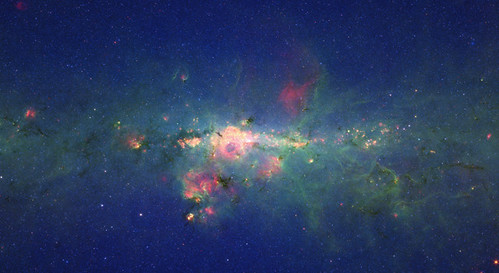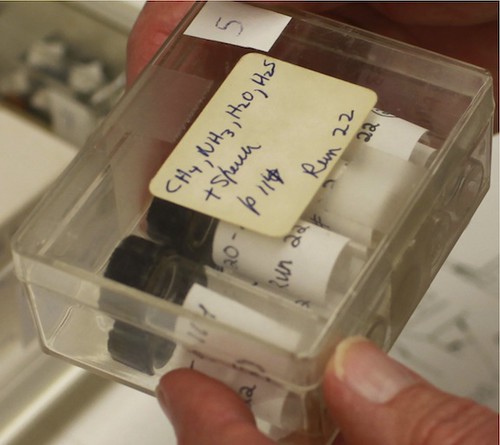Awesomeness Round-up – 3/28/11
- By Maggie Masetti
- March 28, 2011
- Comments Off on Awesomeness Round-up – 3/28/11
The center of our galaxy glows in this infrared image taken by the Spitzer Space Telescope. This data was originally part of a more complete view of the plane of the Milky Way, but then was given different contrast to better highlight the features of this region around the galactic center. The blue haze that brightens towards the center of the image is due to the sheer number of stars, the green is from carbon-rich dust molecules (called polycyclic aromatic hydrocarbons or PAHs) swirling around the galaxy’s core, illuminated by starlight. The yellow-red patches are thermal glow from warm dust. PAHs, dust and clouds of gas are ingredients needed for star formation. The bright feature in the very center is a cluster of stars orbiting the massive black hole at our galaxy’s center. Read more at JPL’s press release.

Credit: NASA/JPL-Caltech
The James Webb Space Telescope has a giant, tennis-court-sized sunshield. Just like a beach umbrella protects you on the beach from the sun’s heat and ultraviolet radiation, the sunshield protects the telescope and sensitive infrared instruments from the sun’s heat and light. Deputy Project Manager John Durning said, “Each of the five layers of the shield is less than half the thickness of a piece of paper. The five work together to create an effective SPF (or Sun Protection Factor) of 1,000,000.” That’s pretty cool – you can read more in the original web feature.
Below is a photo of the paper-thin material the sunshield is made from – it’s called Kapton.

Credit: NASA
Remember the NASA/Etsy space-craft contest? Well, the winners have been announced! Be sure to take a look. There’s also a NASA news release. One of the winners is below – average_jane_crafter’s entry for best 2-D art.

Credit: average_jane_crafter
What do you think the sounds of the universe are? Sometime people are driven to compose music they think encapsulates the essence of space. Here is one of Geodesium’s compositions. The caption says, “This piece draws its inspiration from the Loch Ness Productions fulldome video “HUBBLE Vision”, and uses 19 Hubble Space Telescope images of stellar outbursts. Evocative scenes range from planetary nebulae to dramatic explosions heralding the inevitable death of the luminous blue variable star Eta Carinae, and echoes of light from the red variable star V838 Monocerotis that illuminate clouds of gas and dust surrounding it. Their mesmerizing motion is set to “Light Echoes”, a dramatic, hypnotic Geodesium space music composition that speaks to the depths of the cosmos.”
Is there a real soundtrack to the universe? Well, though we know there is no sound in space, in a vacuum, you can translated physical phenomena into sound. Watch this TED talk by physicist Janna Levin for her interpretation.
Back in early 1998 Edward Morgan of MIT took the Rossi X-ray Timing Explorer data from the black hole GRS 1915+105, and translated it into audio signals, allowing us to actually listen to it throw off its accretion disk.
In astrobiology news, there was recent analysis of an experiment done in the 1950s by scientist Stanley Miller. Miller’s original experiment showed how simple molecules could be assembled into the more complex molecules necessary for life by natural processes, like lightning in Earth’s ancient atmosphere. After Miller’s death in 2007, vials containing samples from the original experiments were discovered and in 2008, a team of NASA and university researchers, analyzed these samples with modern equipment to see if they could discover chemicals that could not be detected with the techniques of the 1950s. The team discovered that the experiment created amino acids containing sulfur, which are significant in the biology of early life. In fact, it’s possibly that primordial volcanic plumes may have played a role in the formation of Earth’s first organic compounds. The news release has the full story.

Credit: Jeffrey Bada and Robert Benson/Scripps Institution of Oceanography, University of California at San Diego


